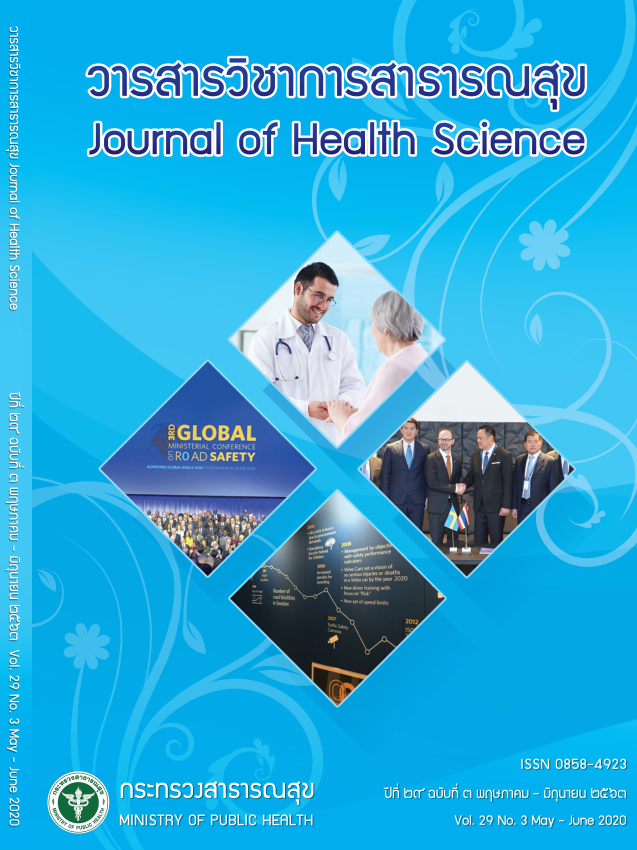Policies and Regulations to Reduce the Impact of Food Marketing Communication on Children Aged Below 16 Years
Keywords:
food marketing, children aged below 16 years, impact of food communication marketing, obesityAbstract
This article aimed to study the policies and regulations to control food or beverage marketing communication affecting children aged below 16 years, which is group of high rate obesity. Marketing communication policy is the way to reduce the impact of food marketing on children. Children are more likely to be influenced by the food marketing because they cannot be able the think critically about the advertisements of marketing to which they are exposed. Consequently, children are often the target of food and beverages marketing communication and may be affected both health problems and long-term behavior. In Thailand, there are no regulations to protect children and youth from harmful impact by marketing communication. There is only an Act relating to consumer protection and restricting advertising. For the results of WHO evaluation shows that the marketing communication control policies in 59 countries havemade very little progress. In spite of the obesity epidemic, it is very common among children aged 12-16 years. And there is no government in any countries push policies that focus on teenagers. Policies or legal regulations should be based on the involvement of stakeholders such as Singapore, which is driven by public-private partnerships and the government, with the same goal of children well- being. Which make everyone aware of the importance of protecting children and sharing responsibility. Besides, the policy may not be so strict that one party feels lose. The policy must be consistent with the problem and always updated to keep up with changes in food marketing or life style and marketing strategies and also cover all types of marketing. This article is a systematic review related to government-controlled measures and policies for marketing communications in children from relevant literature between the years 2007-2017 at the world level and Thailand.
Downloads
References
Wilcox LB, Kunkel D, Cantor J, Dowrick P, Linn S, Palmer E. Report of the APA task force on advertising and children. American Psychological Association. Pub-lic Affairs Office [Internet]. 2004 [cited 2017 Aug 12]. Available from: https://www.apa.org/pi/families/re-sources/advertising-children.pdf
Leigh G. Food advertising policy in the United States. [Internet]. International Food Policy Research Institute. 2007 [cited 2017 Aug 15]. Available from: http://www.foodsecurityportal.org/sites/default/files/FoodAd-vertisingPolicy.pdf
Rozendaal E, Reijmersdal EA, Buijzen M. Reconsidering advertising literacy as a defense against advertising effects. Media Psychology [Internet]. 2011 [cited 2017 Aug 28];14(4):333-54. Available from: http://www. tand-fonline. com/ doi/ full/ 10. 1080/15213269. 2011. 620540.
สำนักงานสถิติแห่งชาติ. สรุปผลสำคัญการใช้เทคโนโลยีสารสนเทศและการสื่อสารในครัวเรือน; 2556 [อินเทอร์เน็ต]. [สืบค้นเมื่อ 10 ต.ค. 2560]. แหล่งข้อมูล: https://www.ryt9.com/s/nso/1747712
World Health Organization. Global strategy on diet, physical activity and health-2004 [Internet]. [cited 2017 Aug 15]. Available from: https://apps.who.int/iris/bitstream/handle/10665/43035/9241592222_eng.pdf
World Health Organization. Global action plan for the prevention and control of non-communicable diseases 2013-2020 [Internet]. [cited 2017 Sep 20]. Available from: https://apps.who.int/iris/bitstream/handle/10665/94384/9789241506236_eng.pdf;jses-sionid=C1AA805572F3A9DF38448152C24661F5? sequence=1
Chou SY, Rashad I, Grossman M. Fast-Food restaurant advertising on television and Its influence on childhood obesity. Journal of Law & Economics 2008;51(4):599-618.
Veerman JL, Van Beeck EF, Barendregt JJ, Mackenbach JP. By how much would limiting TV food advertising reduce childhood obesity?. Eur J Public Health 2009; 19(4):365–9.
คณะกรรมการสิทธิมนุษยชน. หลักกฎหมายระหว่างประเทศทั่วไปเกี่ยวกับสนธิสัญญาด้านสิทธิมนุษยชน. อนุสัญญาว่า-ด้วยสิทธิเด็ก. กรุงเทพมหานคร: สำนักงานคณะกรรมการ-สิทธิมนุษยชนแห่งชาติ; 2530
สำนักงานกองทุนสนับสนุนการสร้างเสริมสุขภาพ. จุดเปลี่ยนการตลาดอาหารเด็กในประเทศแคนาดา [อินเทอร์เน็ต]. 2551 [สืบค้นเมื่อ 13 ต.ค. 2560]. แหล่งข้อมูล: https://tinyurl.com/s8lpxsx
มูลนิธิศูนย์นมแม่แห่งประเทศไทย. ที่มา Milk code; 2560. [อินเทอร์เน็ต]. [สืบค้นเมื่อ 10 ต.ค. 2560]. แหล่งข้อมูล:https://thaibf.com/%E0%B8%97%E08%B5%E0%B9%88%E0%B8%A1%E0%B8%B2-milk-code/
World Health Organization. Resolution of the Sixty-Third World Health Assembly adopted 21 May 2010: WHA63.14. Marketing of food and non-alcoholic bev-erages to children, set of recommendations on the mar-keting of foods and non-alcoholic beverages to children [Internet]. [cited 2017 Sep 25]. Available from: https://apps.who.int/gb/ebwha/pdf_files/WHA63-REC1/WHA63_REC1-en.pdf
Australian National Preventive Health Agency. Australian national preventive health agency strategic plan 2011–2015 [Internet]. [cited 2017 Sep 20]. Available from: http://www.nationalplanningcycles.org/sites/default/files/country_docs/Australia/strategic_plan_2011-2015.pdf
Swinburn B, Wood A. Progress on obesity prevention over 20 years in Australia and New Zealand. Obes Rev [Internet]. 2013 [cited 2017 Sep 17];14(Suppl 2): 60-8. Available from: https://onlinelibrary.wiley.com/doi/pdf/10.1111/obr.12103
World Health Organization. Reducing the marketing of unhealthy foods to children [Internet]. [cited 2017 Sep 20]. Available from: http://www.who.int/chp/media/news/releases/2011_1_marketing/en/.
Kraak VI, Vandevijvere S, Sacks G, Brinsden H, Hawkes C, Barquera S, et al. Progress achieved in restricting the marketing of high-fat, sugary and salty food and bever-age products to children. Bull World Health Organ 2016;94(7):540-8.
Sandelson D, Hiester E. Communications Act 2003: The highlights [Internet]. Thomson Reuters Practical Law. 2003 [cited 2017 Mar 28]. Available from: file:///C:/Users/kanyapat/Downloads/Communications%20Act%202003%20The%20highlights.pdf
Reynolds J. New restrictions on HFSS ads aimed at children in UK [Internet]. [cited 2017 Feb 24]. Available from: http://www.foodingredientsfirst.com/news/Ne-wRestrictionsonHFSSAdsAimedatChildreninUK?
Harris JL, Bargh JA, Brownell KD. Priming effects of television food advertising on eating behavior. Health Psychol [Internet]. 2009 [cited 2017 Aug 21]; 28(4): 404-13. Available from https://www.ncbi.nlm.nih.gov/pubmed/19594263
Ministry of Health, Singapore. Press release by the Com-mittee on Guideline for Food Advertising to Children. Food and media industries to comply with guidelines for food advertising to children from 1 January 2015 [In-ternet]. 2015 [cited 2017 Jul 5]. Available from: https://asas.org.sg/Portals/0/Images/ASAS/news/Children_Code/Press_release_Food_advertising_guidelines_for_children.pdf
สำนักข่าวอิศรา. ศูนย์เด็กเล็กอ่อนหวาน ร.ร.ปลอดน้ำอัดลม สู่ตำบล “ดื่มน้ำเปล่า” แห่งแรกเริ่มที่บุรีรัมย์ [อินเทอร์เน็ต]. 2558 [สืบค้นเมื่อ 15 ส.ค. 2560]. แหล่งข้อมูล: https://www.isranews.org/thaireform-other-news/37363-burirum.html
European Commission. School food policy country fact-sheets [Internet]. [cited 2017 Aug 28]. Available from: http://www.schoolfoodplan.com/wp-content/up-loads/2014/09/School-Food-Standards-Guidance-FINAL-140911-V2C.pdf
สำนักงานพัฒนานโยบายสุขภาพระหว่างประเทศ. เอกสารการศึกษาวิวัฒนาการ การบังคับใช้ กฎหมายและมาตรการที่กี่ยวข้องกับการโฆษณาอาหาร และเครื่องดื่มที่มีน้ำตาล; 2557 [อินเทอร์เน็ต]. [สืบค้นเมื่อ 15 ส.ค. 2560]. แหล่งข้อมูล: http://ihppthaigov.net/DB/publication/attachre-search/333/chapter6.pdf
นงนุช ใจชื่น, สิรินทร์ยา พูลเกิด, ทักษพล ธรรมรังสี. วิวัฒนาการของกฎหมายและมาตรการที่เกี่ยวข้องกับการโฆษณาอาหารและเครื่องดื่มที่มีน้ำตาล ไขมันและโซเดียมสูงของประเทศไทย. วารสารวิจัยระบบสาธารณสุข 2558; 9(1):80-97.
นงนุช ใจชื่น, วาทินี คุณเผือก, สิรินทร์ยา พูลเกิด, ทักษพล ธรรมรังสี. ช่องว่างและโอกาสในการควบคุมการตลาดอาหารและเครื่องดื่มของประเทศไทย ตามชุดข้อเสนอแนะขององค์การอนามัยโลกว่าด้วยเรื่องการทำการตลาดอาหารและเครื่องดื่มที่ไม่มีแอลกอฮอล์ในเด็ก. วารสารวิจัยระบบ-สาธารณสุข 2558;9(3):213-26.
คณะกรรมการขับเคลื่อนปฏิรูปประเทศ ด้านสาธารณสุขและสิ่งแวดล้อม สภาขับเคลื่อนการปฏิรูปประเทศ. การป้องกันและควบคุมปัจจัยเสี่ยงต่อสุขภาพด้านอาหารและโภชนาการ ในประเด็นการจัดเก็บภาษีเครื่องดื่มที่มีปริมาณน้ำตาลเกินเกณฑ์มาตรฐานสุขภาพ [อินเทอร์เน็ต]. 2559 [สืบค้นเมื่อ 16 ส.ค. 2560]. แหล่งข้อมูล: https://library2.parliament.go.th/giventake/content_nrsa2558/d042659-02.pdf
National Statistical Office and United Nations Children’s Fund.Thailand 14 provinces multiple indicator cluster survey 2015-2016. Final Report. [Internet]. NSO and UNICEF, Bangkok; 2017 [cited 2017 Aug 5]. Available from: https://www.unicef.org/thailand/media/231/file/Thailand%2014%20Provinces%20Multiple%20Indicator%20Cluster%20Survey%20(MICS)%202015-2016.pdf
Downloads
Published
How to Cite
Issue
Section
License

This work is licensed under a Creative Commons Attribution-NonCommercial-NoDerivatives 4.0 International License.







